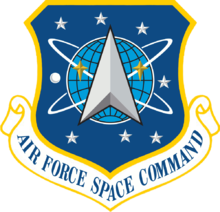Air Force Space Command
The Air Force Space Command ( AFSPC ; German Space Command of the Air Force ) was one of ten main commands of the United States Air Force (USAF). His headquarters were at Peterson Air Force Base in Colorado , USA . Last commanding officer (from 2016 to 2019) was General John W. Raymond .
The AFSPC was the US Air Force's space division and was responsible for launching, operating and monitoring military satellites for reconnaissance , communication and weather data. In addition, the AFSPC operated a global network of radar stations for space surveillance in order to be able to warn of approaching enemy missiles.
The Global Positioning System (GPS), which is also used in the civilian sector, is operated and monitored by the 50th Space Wing of the former AFSPC at Schriever AFB , Colorado .
Since 2009, the area of responsibility has also included cyber warfare .
From 1993 to 2009, the Space Command was also responsible for the land-based US ICBMs (around 500 missiles of the LGM-30G Minuteman III type ).
The AFSPC included the
- 14th Air Force , Vandenberg AFB (satellites, radar)
- 24th Air Force , Lackland AFB (Cyberwar, Air Force part of USCYBERCOM )
In 2011, the Air Force Space Command had around 42,000 personnel.
history
Since the possibilities and importance of military satellites increased steadily since the 1970s , the USAF established a Space Command on September 1, 1982 to cover this area. On November 15, 1985 , the name was changed to Air Force Space Command . On July 1, 1993, the AFSPC finally took over responsibility for the ICBMs that had previously been with the Air Combat Command . In 2009 there was a major restructuring: The 20th Air Force , which was responsible for ICBMs , was transferred to the newly founded Air Force Global Strike Command , in return the Space Command and the 24th Air Force were given responsibility for cyber warfare.
On June 18, 2018, US President Donald Trump announced a decree to create the United States Space Force as the sixth military force. The United States Space Force took over the tasks of Air Force Space Command in December 2019.
Orbit determination of satellites
To determine the orbit data of earth satellites , the United States Air Force's 20th Space Control Squadron operates a multistatic radar consisting of three transmitting and six receiving stations at 33 ° north latitude under the motto Detect - Track - Identify . The transmitters generate an RF fence at a frequency of 216.98 MHz , which extends from the Atlantic to the Pacific in an east-west direction and is 0.02 ° thick in a north-south direction (at an altitude of 15,000 km). Satellites with a sufficiently large orbital inclination regularly pass this RF field on their orbit so that the time, direction and Doppler shift of the scattered signals can be recorded by the receiving stations with phase array antennas to determine the orbit. The reception of the radar echoes is also possible with amateur means.
AFSPC satellites
Air Force Space Command satellites that were active on August 4, 2008 are listed below.
Web links
- Site of the former Air Force Space Command (English)
- US Air Force Fact Sheet - Air Force Space Command ( Memento December 23, 2014 in the Internet Archive )
Individual evidence
- ↑ The Latest: Trump tells Pentagon to create "Space Force". In: abcnews.go.com. June 18, 2018, archived from the original on June 18, 2018 ; accessed on June 18, 2018 .
- ↑ Marina Koren: What Does Trump Mean By 'Space Force'? . The Atlantic . March 13, 2018.
- ^ US Naval Space Command Space Surveillance System. Federation of American Scientists, accessed September 5, 2012 .
- ↑ Volker Grassmann: NAVSPASUR Radar Experiments. April 6, 2006, accessed September 5, 2012 .
- ↑ http://www.globalsecurity.org/space/systems/xss.htm
- ↑ http://www.spacetoday.org/Satellites/XSS_11/XSS_11.html
- ↑ http://www.fas.org/spp/military/program/sigint/vortex2.htm
- ↑ http://www.globalsecurity.org/space/systems/mti.htm
- ↑ http://www.sandia.gov/LabNews/LN03-24-00/mti_story.html
- ↑ http://www.globalsecurity.org/space/systems/sldcom.htm
- ↑ http://www.globalsecurity.org/space/systems/trumpet.htm


